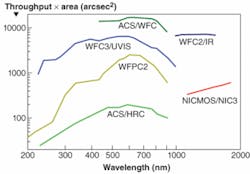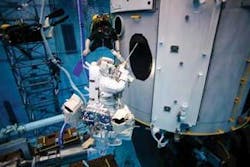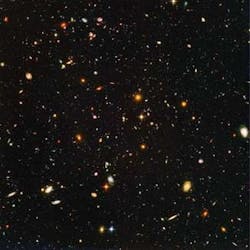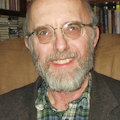Photonic Frontiers: Upgrading Hubble - Hubble to get its final makeover
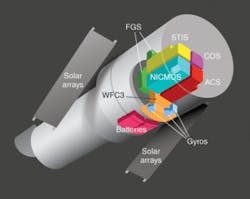
Ground-based astronomers boast about the exquisite detail they can see when adaptive optics are installed on giant terrestrial telescopes that dwarf the 2.4 m Hubble Space Telescope. Yet despite its modest size, Hubble remains a unique astronomical resource. In orbit, Hubble sees the dark sky of space, allowing it to study objects fainter than the scattered light and thermal glow of the atmosphere. Hubble’s sharp resolution extends across a much larger field of view than today’s adaptive-optics systems can correct for aberrations. And Hubble’s image stability is absolute, so it can go back again and again to stare repeatedly at the same spot in the sky, whether to build up long exposures or to precisely repeat observations. Nothing on the ground could record the cosmic panorama of the Ultra Deep Sky Survey, says Ken Sembach of the Space Telescope Science Institute (Baltimore, MD).
The public, as well as astronomers, love Hubble. When former NASA Administrator Sean O’Keefe canceled the final service mission in 2004, critics all but called for his head on a pike. His successor Mike Griffin was cheered when he revived the repair mission, now scheduled to be launched on Aug. 28 on the space shuttle Atlantis.
Like the first service mission, the final one poses big challenges. This time astronauts hope to replace failed circuit boards on two instruments already on board—the Advanced Camera for Surveys and the Space Telescope Imaging Spectrograph—a first because the instruments weren’t designed for such servicing. The mission will also add two new instruments, the Wide Field Camera 3 (WFC3) and the Cosmic Origins Spectrograph. And six new gyroscopes, a fresh set of batteries, and one of three on-board Fine Guidance Sensors, will also be replaced—which NASA hopes will keep Hubble going until after the launch of the James Webb Space Telescope, set for 2013 (see www.laserfocusworld.com/articles/ 277182). Hubble instruments along with internal equipment will be replaced on this mission (see Fig. 1).
New instruments
The WFC3 is the third in a series of wide-field cameras built to image objects ranging from planets in our solar system to distant galaxy clusters. The original Wide-Field Planetary Camera (WFPC) was among the instruments launched with Hubble in 1990; the existing Wide-Field Planetary Camera 2 (WFPC2), installed during the 1993 repair mission, compensated for Hubble’s defective primary mirror. The WFPC2 has been a workhorse and is responsible for many of Hubble’s most famous photos, such as the iconic photo of pillars of gas in star-forming areas of the Eagle Nebula, but today’s optical technology is far beyond the state of the art of 15 years ago.The WFPC2 had a single optical system that focused light onto four 640,000-pixel detector arrays with response from the near-ultraviolet to the near-infrared. Now WFC3 splits light between two optical systems running parallel to each other. One delivers its share of the light to an ultraviolet-visible channel, which focuses light onto a 16-megapixel array with response between 200 and 1000 nm. The other delivers light to a thermoelectrically cooled one-megapixel mercury cadmium telluride array with response at 850 to 1700 nm. The infrared array rejects wavelengths longer than 1700 nm, blocking thermal radiation and avoiding the need for cryogenic cooling that would limit operating lifetime.
These changes make WFC3 far more sensitive than WFPC2. The new instrument also shines in what NASA calls “discovery efficiency,” the product of sensitivity times field of view (which depends on array resolution; see Fig. 2). In the ultraviolet and blue, WFC3 has a discovery efficiency 7 to 16 times higher than WFPC2. In the near-IR, the discovery factor is 10 to 30 times higher than the existing NICMOS (Near-Infrared Camera and Multi-Object spectrometer), which has a 65,000-pixel array and is to be replaced on this service mission.
However, WFC3 does not match the sensitivity of the existing Advanced Camera for Surveys at 500 to 800 nm. The two were designed to work in tandem, says Sembach. “It’s difficult to optimize the whole spectrum, so we chose to optimize those parts of the spectrum that ACS was not optimized for,” he says.
With high sensitivity across a broader spectral range than any previous instrument, WFC3 is Hubble’s first panchromatic camera. Its infrared response can reach out to the very distant universe to see very young, red-shifted galaxies, and peer through dust to look into the hearts of star-forming regions. At ultraviolet wavelengths, WFC3 can spot the light from newborn stars.
The second new instrument, the Cosmic Origins Spectrograph, records spectra at 120 to 300 nm. The COS can collect light 10 to 30 times more efficiently than the existing Space Telescope Imaging Spectrograph, but uses a different design that does not allow imaging targets. The improvement comes from a novel design that uses a single curved holographic ruled grating to simultaneously reflect, focus, and disperse incoming light. That avoids the high losses inherent in multiple reflections of earlier designs, such as the slit spectrograph in STIS. “It’s very nice, but not very easy to manufacture,” says Sembach.
The high throughput of COS for ultraviolet observations is important for studies of the intergalactic medium. Astronomers have traced a filamentary web of gas crossing the universe, with galaxies forming at the intersections. Ultraviolet spectra can help understand the properties and distribution of that gas, which is the raw material of the universe. Sensitive ultraviolet spectral observations also may reveal atmospheres on planets outside the solar system as well as the interstellar medium in our galaxy.Repairing old instruments
The big challenge for astronauts will be to replace failed circuit boards on ACS and STIS. Hubble was designed so astronauts could replace old instrument modules with new ones, so they will install WFC3 after removing WFPC2 and put COS into the slot occupied by the COSTAR module installed in 1993 to compensate for the flawed primary mirror. The ACS and STIS were not designed to be opened and repaired in space, but astronomers and NASA decided the instruments were important enough to try. Astronauts train for the delicate mission in buoyancy tanks that simulate weightlessness (see Fig. 3).The ACS will remain Hubble’s most sensitive camera through most of the visible spectrum. That sensitivity allowed it to record the remarkable Hubble Ultra Deep Field image over a total of 11.3 days of observing, revealing distant galaxies as faint as 30th magnitude (see Fig. 4). However, a power failure in January 2007 crippled ACS by disabling the critical wide-field and high-resolution observing channels, leaving only the solar-blind channel operational. Current plans call for replacing the CCD electronics box in the wide-field channel with a new box, which will include a replacement for low-voltage power supply serving all of ACS that is thought to have failed. The first priority is reviving the wide-field channel, but planners hope that the repair might restore the high-resolution channel as well.
Although STIS is not as efficient as COS, its spectral response covers the visible and some of the near-infrared. Its slit design gives it imaging capabilities, so it can record spectra across objects such as galaxies or gas clouds. At the time a power supply failure disabled it in August 2004, it was performing about 30% of Hubble observations. To access the inside of the STIS electronics module, astronauts will have to remove and capture 111 small fasteners. Then they will replace the failed components and snap a new cover into place that does not require fasteners. They also will attach a passive radiator to cool STIS when COS is in place beside it.
Other repairs are more routine but critical to keeping Hubble running well into the next decade. The original batteries will be replaced after 18 years in space. All six gyroscopes, which have proved the most short-lived Hubble components, also will be replaced, as will one of the three existing fine-guidance sensors.
Better than new
If all goes well, the refurbished Hubble will be much better than new. The WFC3 will complement a revived ACS to generate more of the striking images that are Hubble’s public hallmark. Likewise, the high sensitivity of COS in the important ultraviolet region complements the ability of STIS to observe spectra at longer wavelengths and of larger objects.
The repairs are intended to keep Hubble running for another five years, and astronomers hope to stretch its lifetime even further so it can observe alongside Webb. However, with Webb limited to the infrared, astronomers are looking at prospects for a new and larger space telescope that will be Hubble’s successor in the ultraviolet and visible regions. Sembach would like to see it launched in 10 to 15 years so it could overlap with Webb, and extend our golden age of astronomy.
About the Author
Jeff Hecht
Contributing Editor
Jeff Hecht is a regular contributing editor to Laser Focus World and has been covering the laser industry for 35 years. A prolific book author, Jeff's published works include “Understanding Fiber Optics,” “Understanding Lasers,” “The Laser Guidebook,” and “Beam Weapons: The Next Arms Race.” He also has written books on the histories of lasers and fiber optics, including “City of Light: The Story of Fiber Optics,” and “Beam: The Race to Make the Laser.” Find out more at jeffhecht.com.
